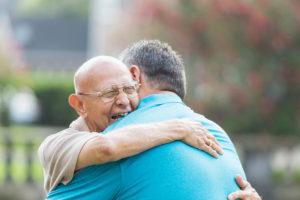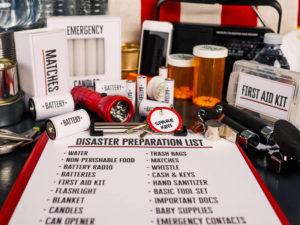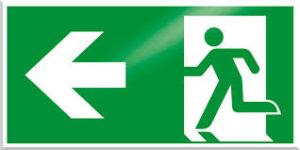Presenting a Disaster Preparedness Workshop at a Seniors Event, there were several general disaster preparedness questions, and I thought if this group of seniors had these questions, I sure many other seniors would also have the same concerns.
Whether you are a senior or a junior or somewhere in between – the key to Earthquake and Disaster Preparedness is to take the necessary steps to ensure you, your family and pets are prepared for whatever disaster comes your way!
Disaster Preparedness Plans must be adapted to work for your unique situation. As we age, we may not be able to do what we used to do – but that is ok – if you need help with the process, make sure you ask.
The following 4-steps will help you develop your Disaster Plan and will provide you peace of mind knowing you have a plan. These 4-steps are a great place to start – but as you work through the steps, you will identify additional steps you may need to complete.
Step 1 – Connecting with Family:
Our family will always be our number one concern when facing a disaster. It is a great idea to identify a family Out of Area Contact. Your contact will be the person all your family members will call when faced with a disaster. With an Out of Area Contact, this will provide your family with a centralized number to call. Your Out of Area Contact is helpful for a couple of reasons, you only have one call to make, and you can find out how other family members are doing. By making only one call and not trying to call all your family members, you are keeping the phones clear for people who need emergency help. In some situations, it can be easier to call long distance than calling locally.
 Social Media is also a great way to connect. Check with your family to see if this makes sense. Often some seniors are not comfortable with the different Social Media platforms, so check with your family to see how this can help.
Social Media is also a great way to connect. Check with your family to see if this makes sense. Often some seniors are not comfortable with the different Social Media platforms, so check with your family to see how this can help.
What’s important here to remember is that the more options you have to connect, the better your chance of connecting with the family will be. Depending on the disaster and how your community has been impacted, connecting may not happen instantly; it may take some time.
Step 2 – Disaster Supplies:
Ensure you have the supplies you will need safely stored away in your Emergency Kits. The two kits I recommend are a Grab & Go Kit in the event you have to evacuate and a Home Kit for when you can stay and survive.
 A Grab & Go Kit is typically used for a house fire, where you may be out of your home for several hours, and your Home Kit is for the longer term – usually prepared to last a week.
A Grab & Go Kit is typically used for a house fire, where you may be out of your home for several hours, and your Home Kit is for the longer term – usually prepared to last a week.
Don’t forget your medications, but make sure you check with your family doctor before storing any medicines. If you have a pet, you will want to ensure you have the supplies they will need.
A great idea that can make life much simpler is when family asks what you want for your Birthday or Christmas, ask them for an Emergency Kit. Buying a ready-made kit can be a great solution to help ensure you are better prepared.
Just remember even with a ready-made kit, you will need to add your items, such as a change of clothes and medications.
Step 3 – Make your Home Safe:
Most injuries in an earthquake happen from people doing the wrong thing or being injured from falling or shooting debris, tumbling bookcases or objects that fall.
If you are unable to do this yourself, reach out to family or friends to help you secure those heavy items. You want to make sure your home is safe for you, your family, grandkids and your pets.
Step 4 – Evacuating your Home:
 Depending on your level of mobility, this may require some extra planning. If you are able-bodied practice evacuating from your house or apartment and go to your family meeting place. If you live in an apartment, remember that the elevators will not be working if there is a fire or significant earthquake, and you will need to use the stairs. Check with your building manager to find out what plans may already be in place. Some buildings will have a refuge area where people who need assistance may gather.
Depending on your level of mobility, this may require some extra planning. If you are able-bodied practice evacuating from your house or apartment and go to your family meeting place. If you live in an apartment, remember that the elevators will not be working if there is a fire or significant earthquake, and you will need to use the stairs. Check with your building manager to find out what plans may already be in place. Some buildings will have a refuge area where people who need assistance may gather.
If maneuvering the stairs is an issue for you – check with your building manager or a neighbour that may be able to assist you. Talk to your neighbours and let them know your concerns and your plans. You will be amazed at how willing they are to help during times of disaster.
